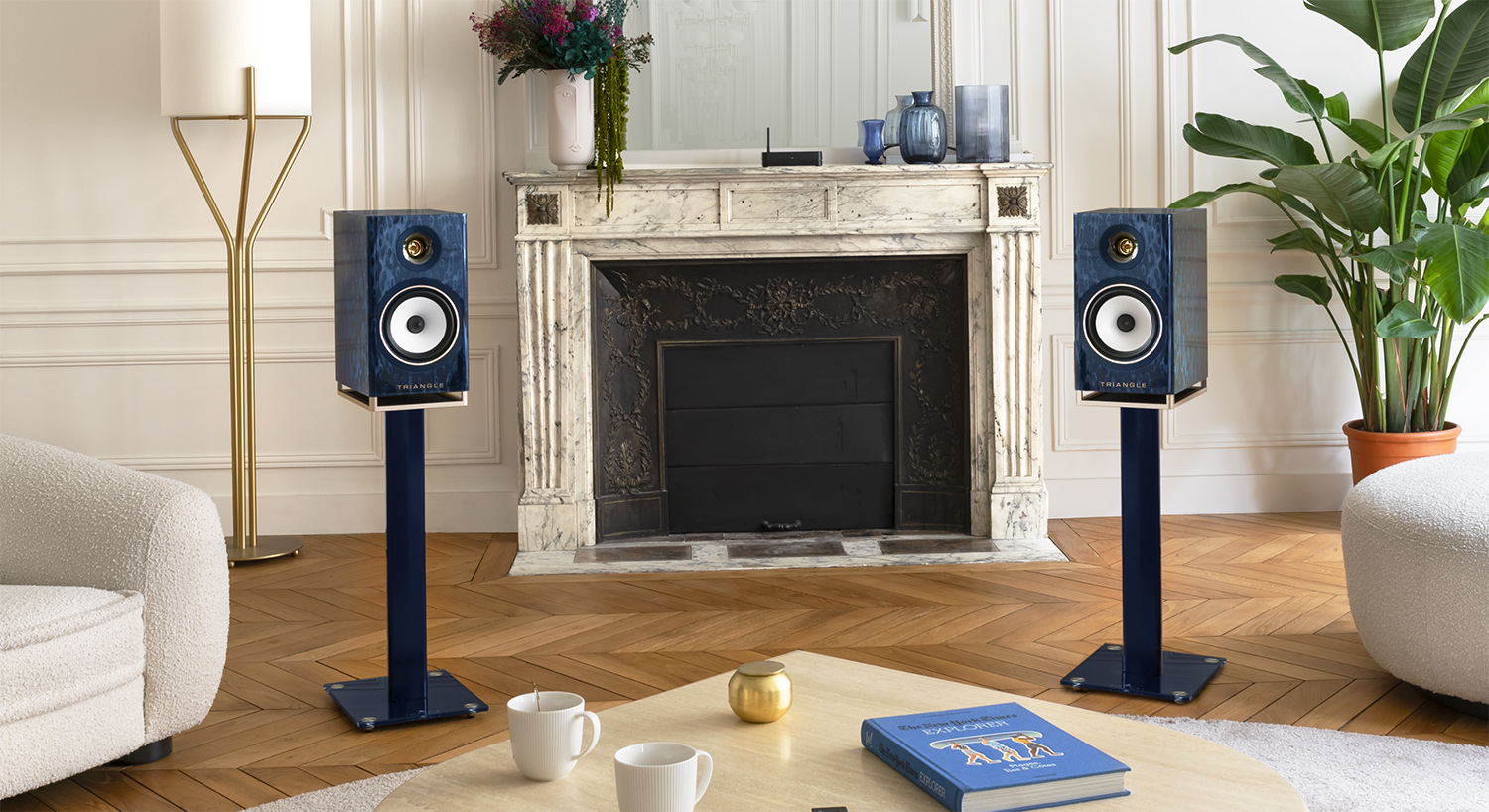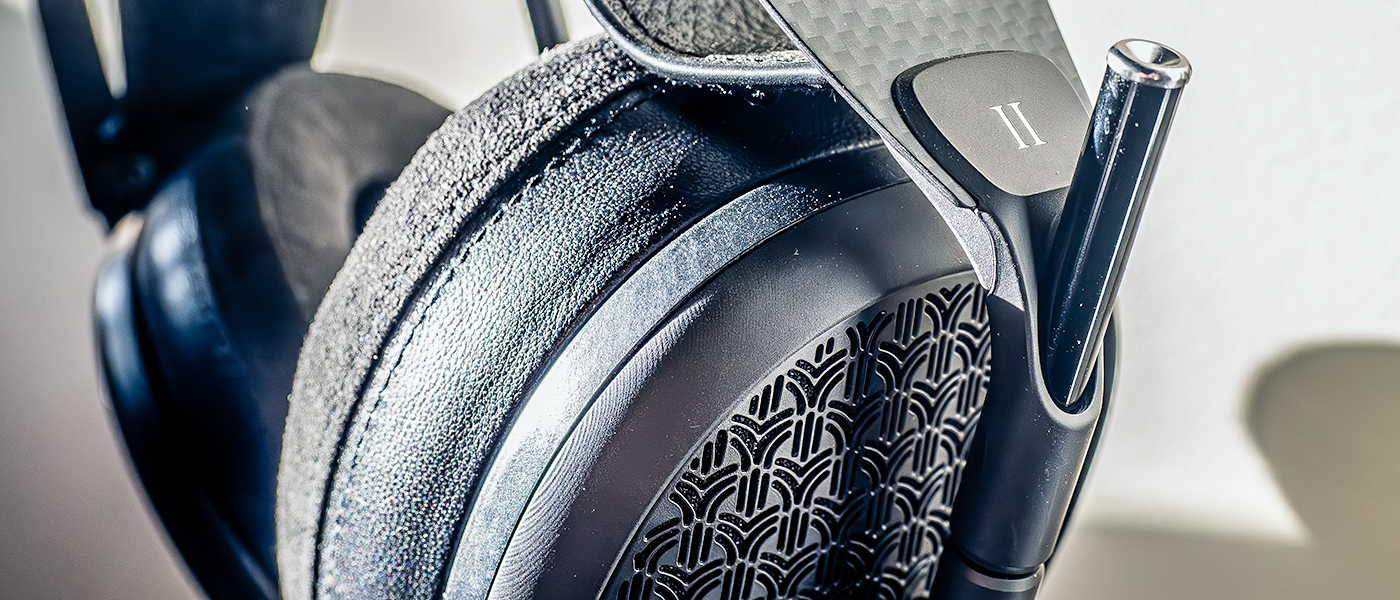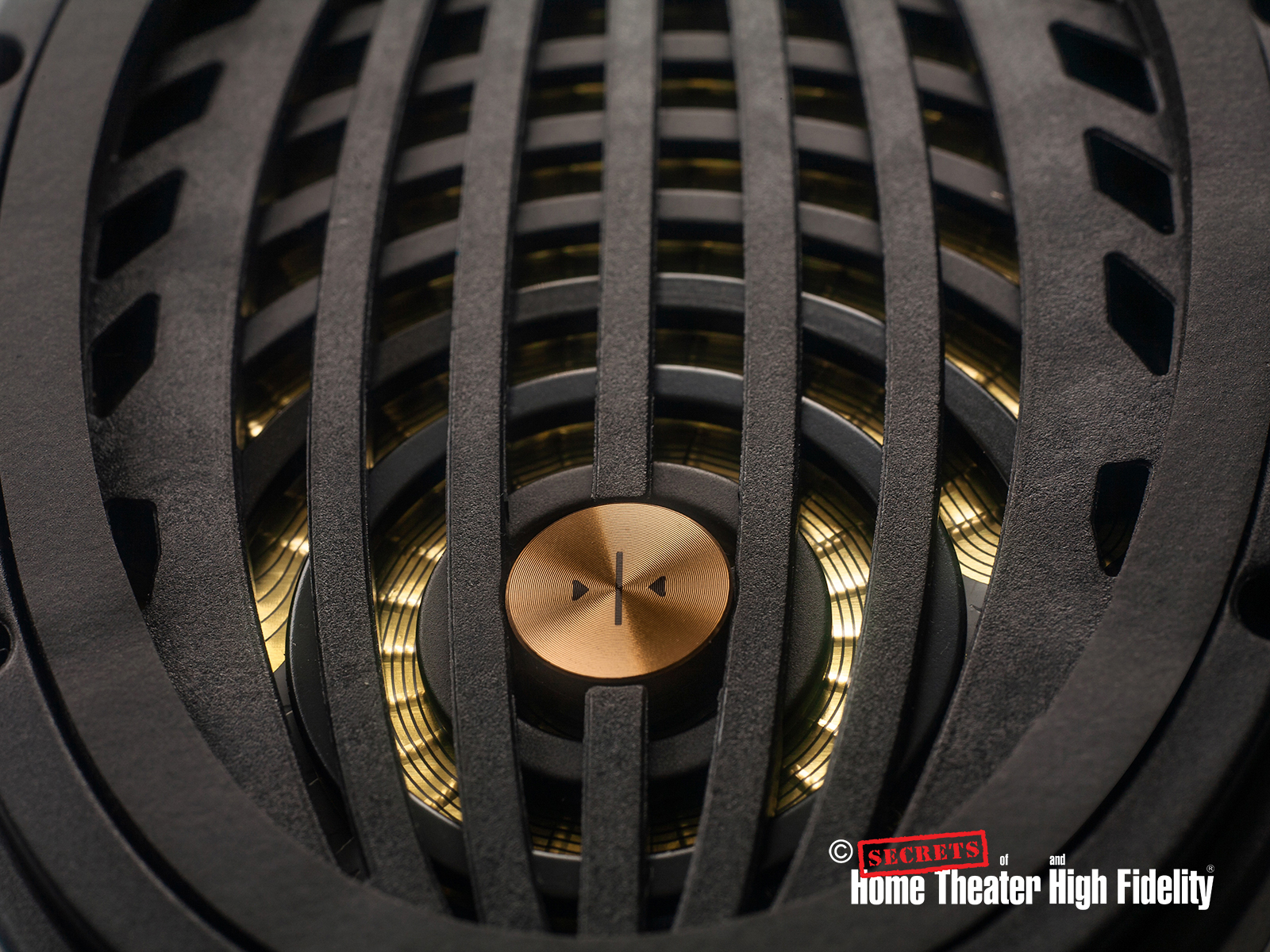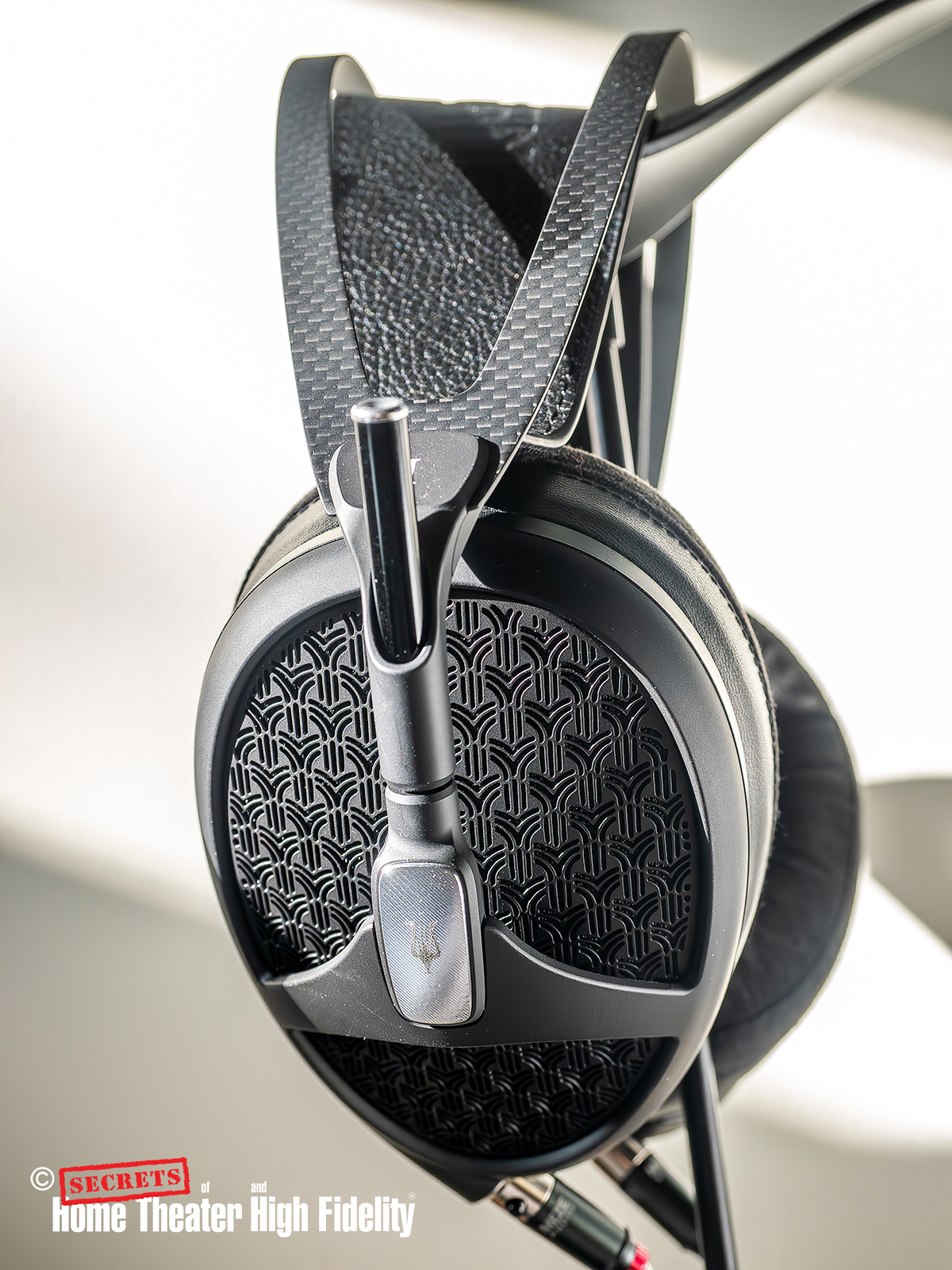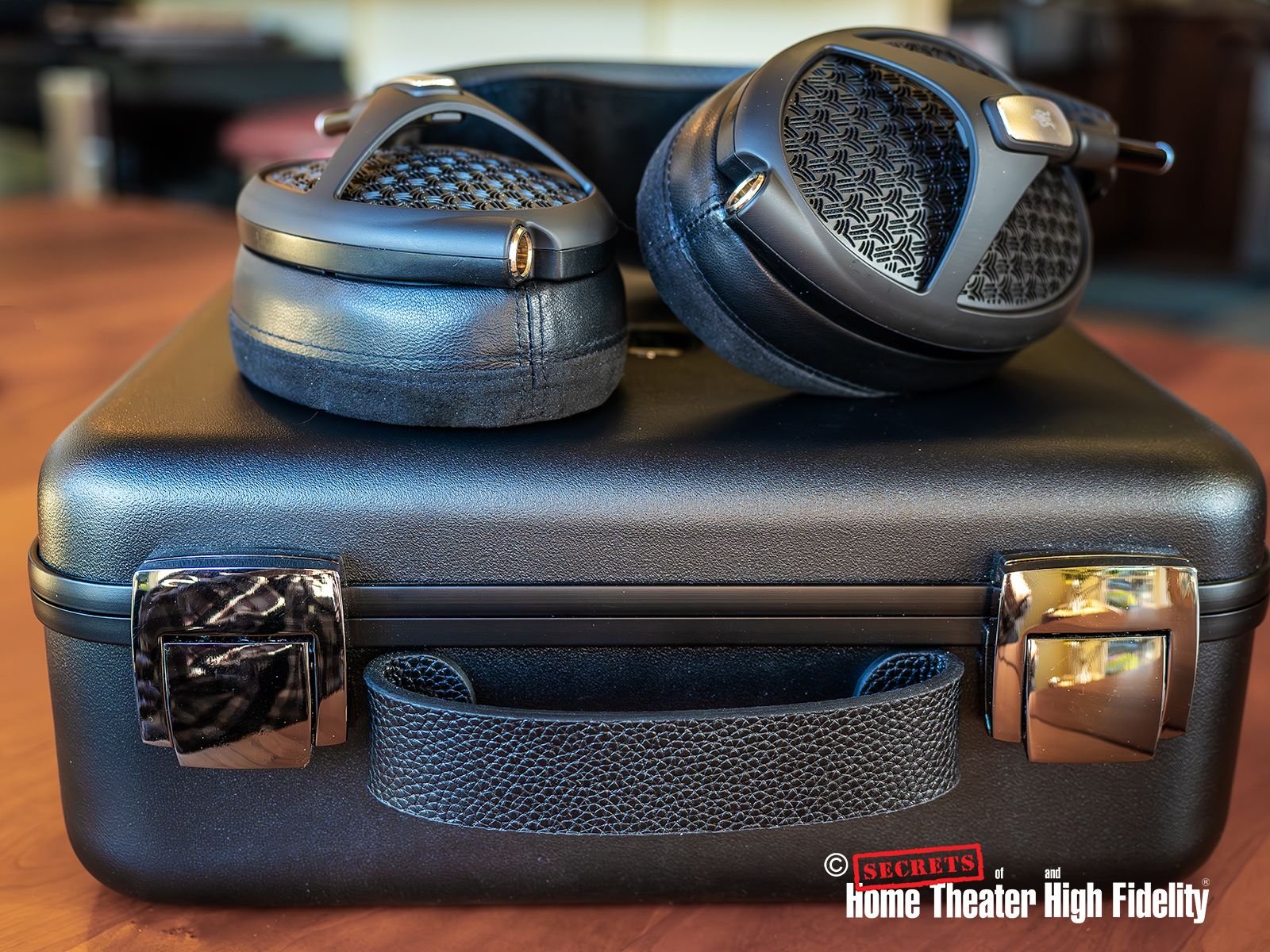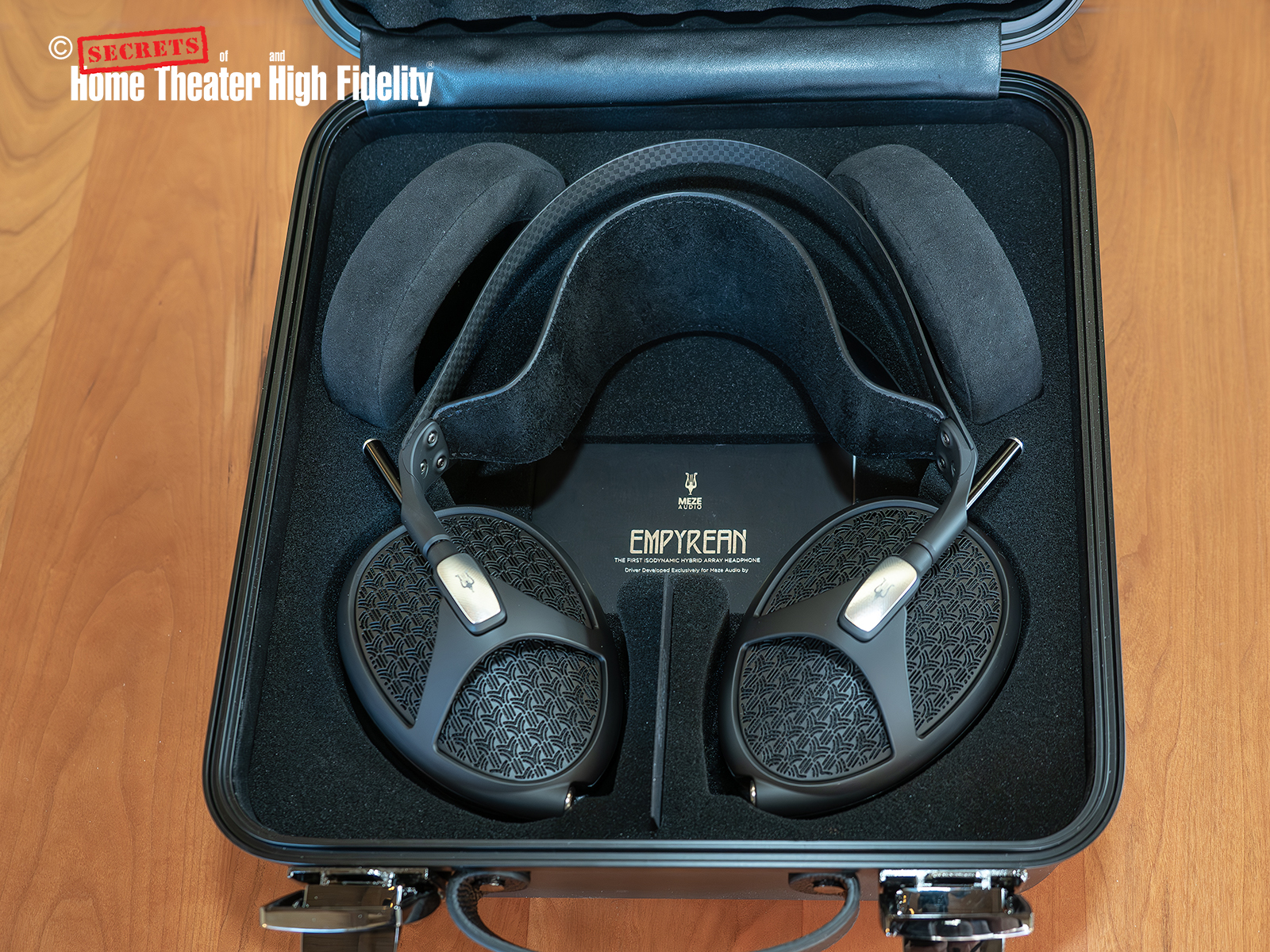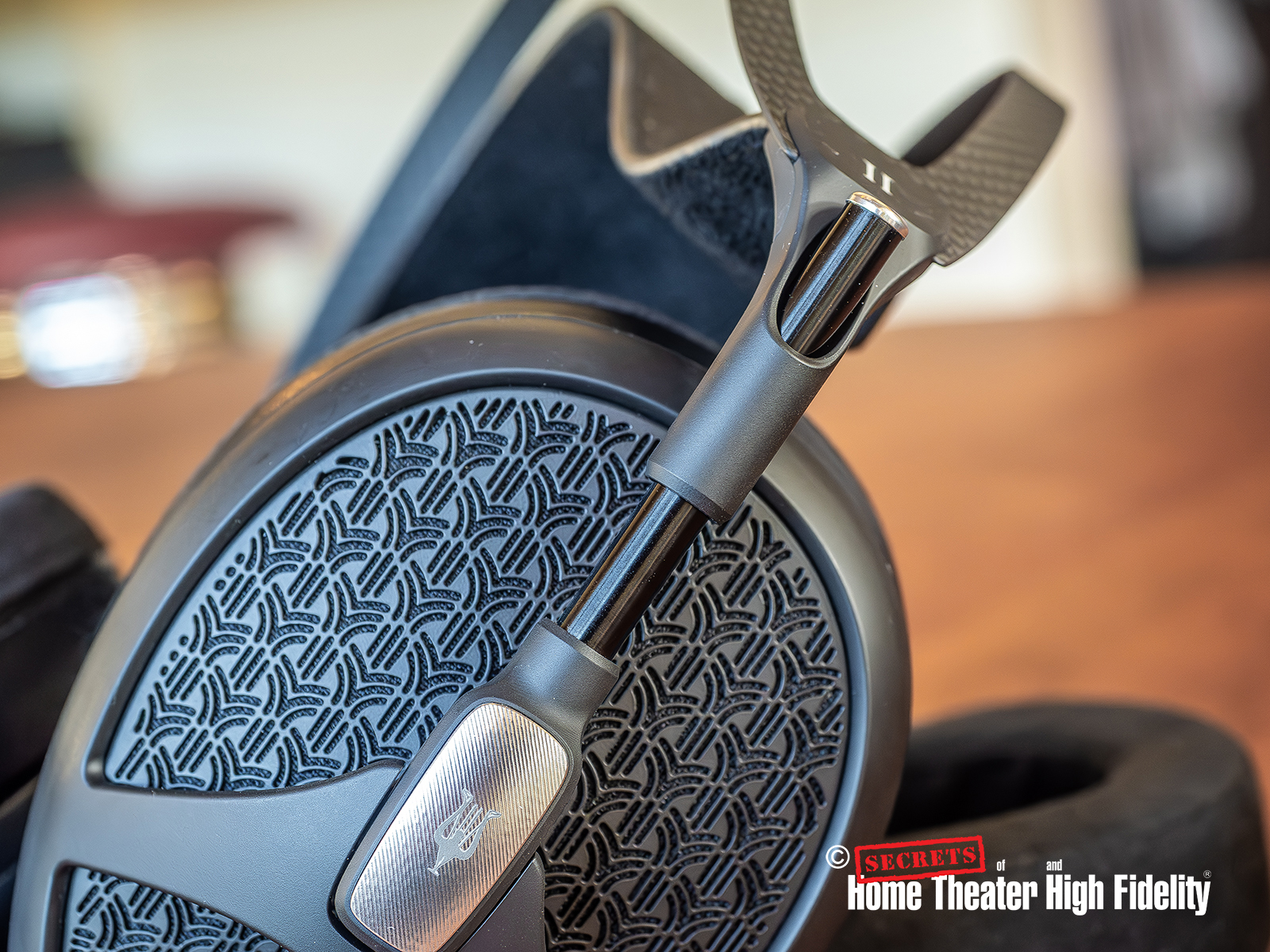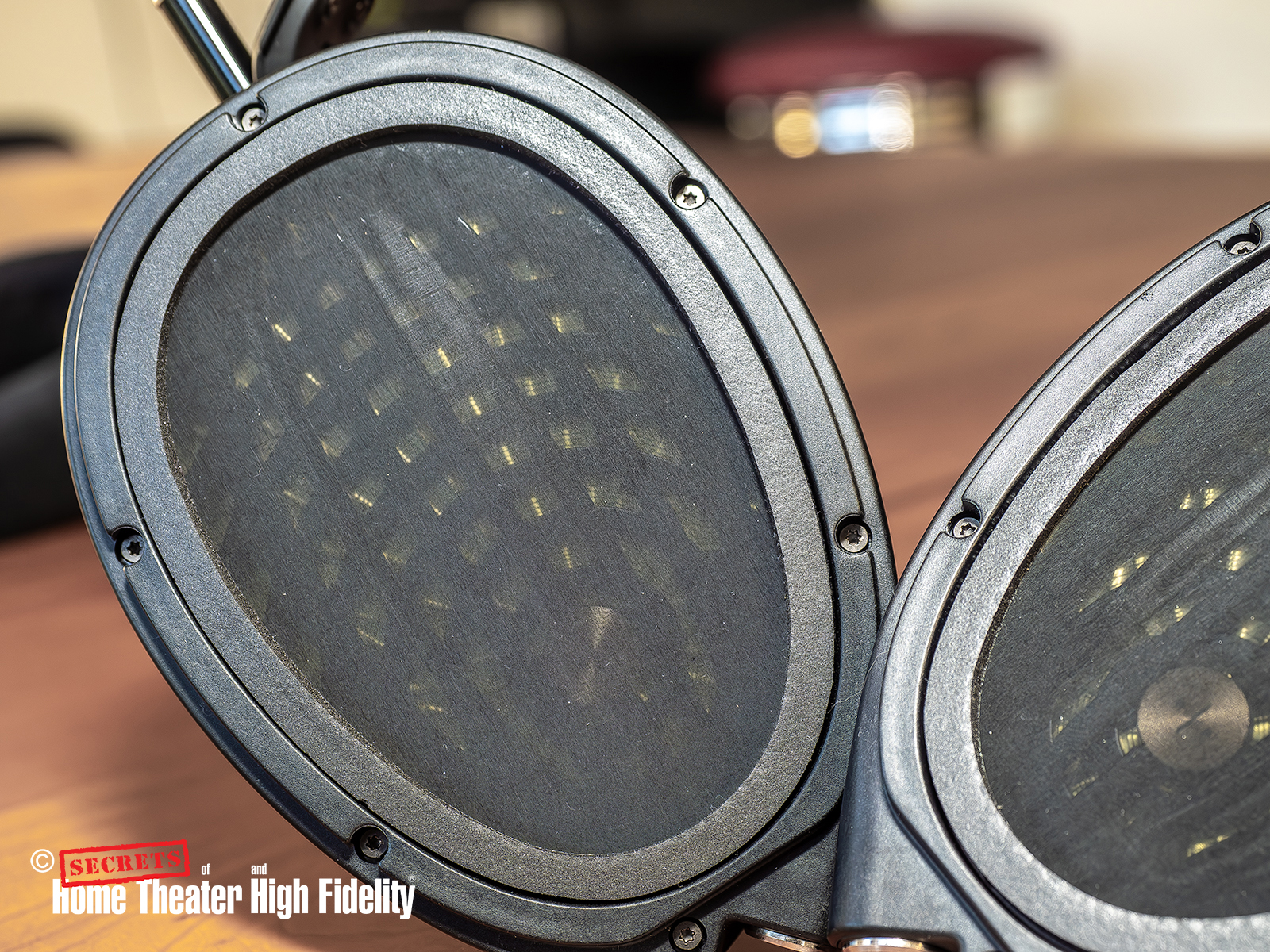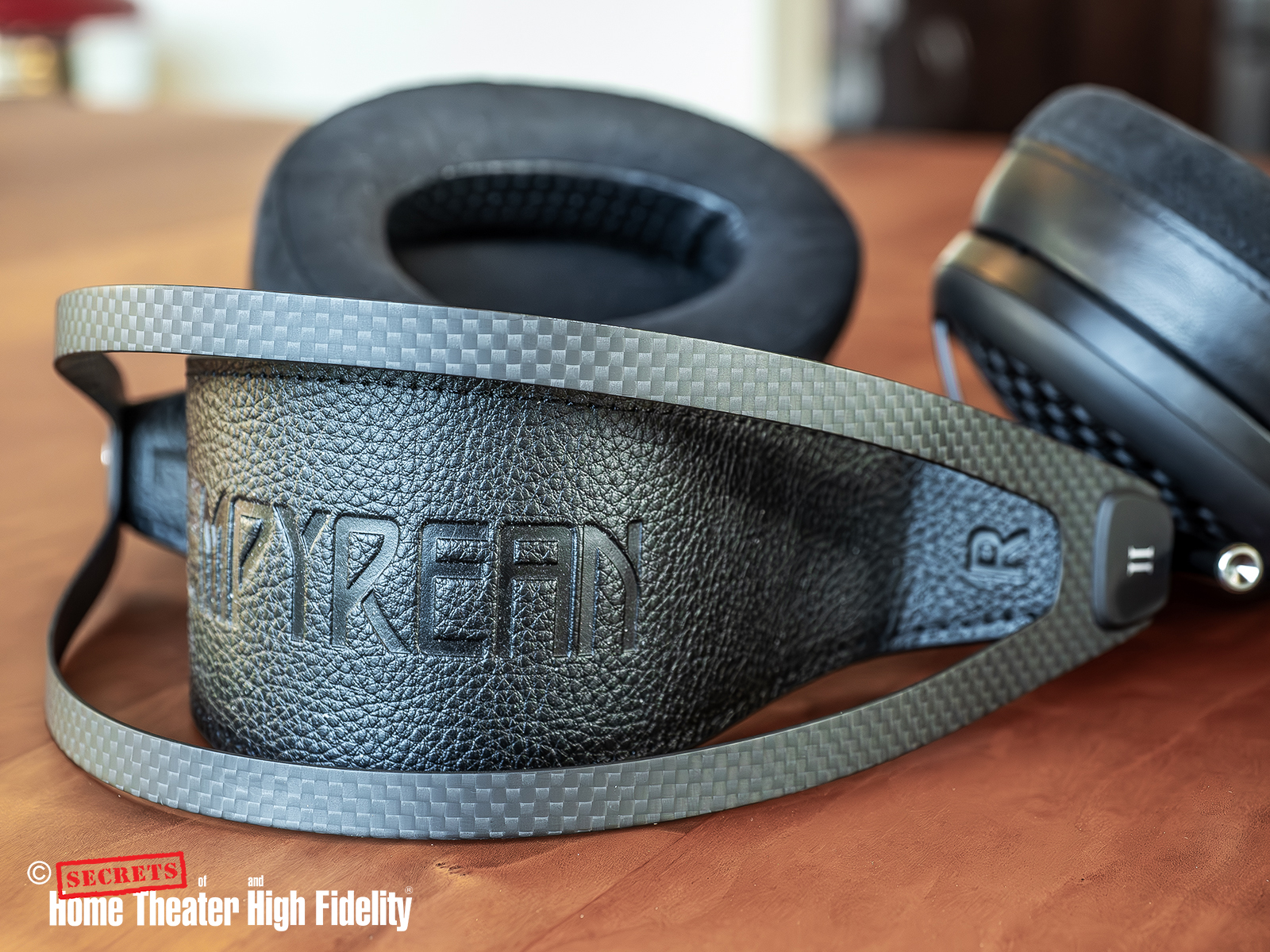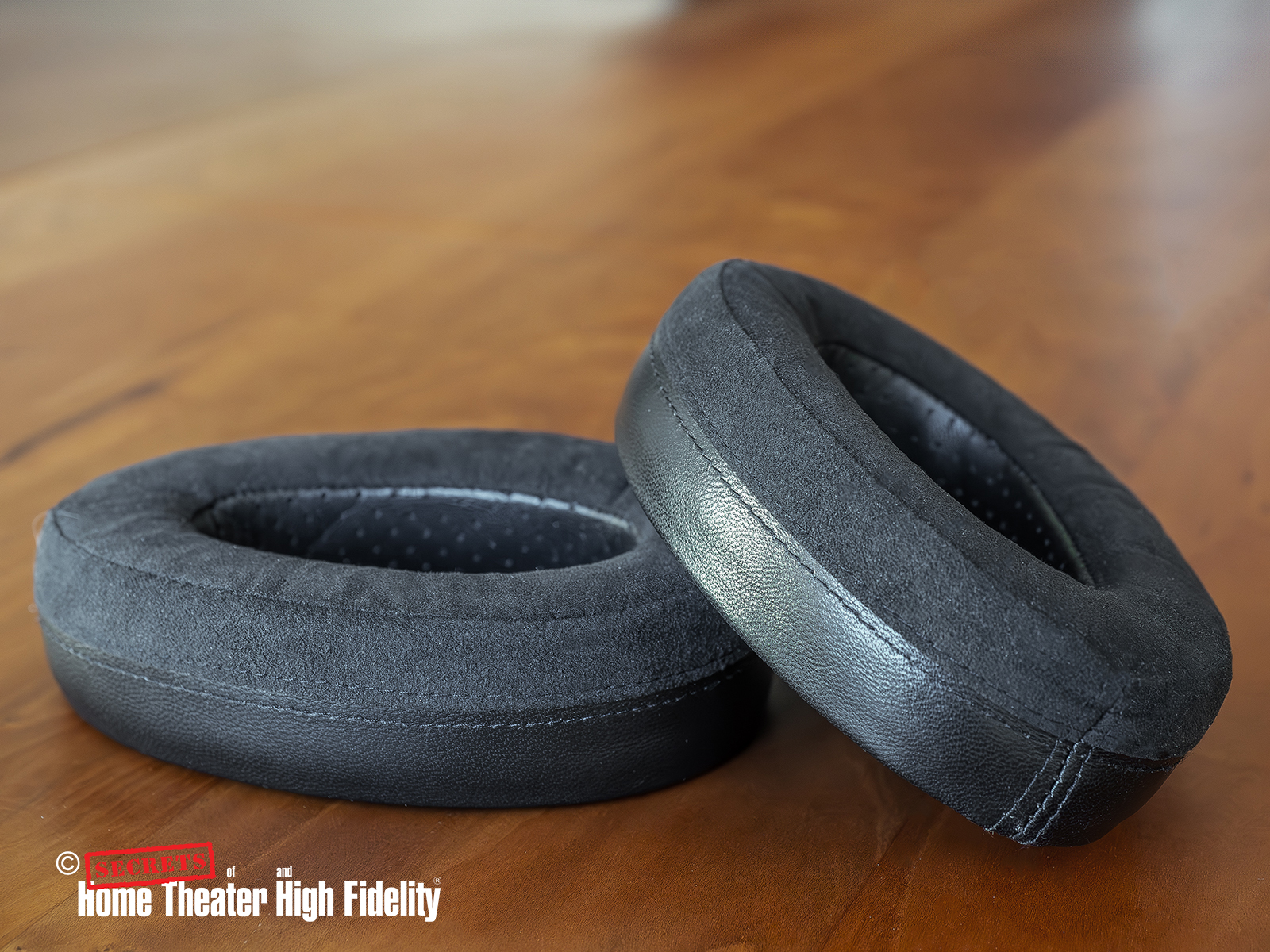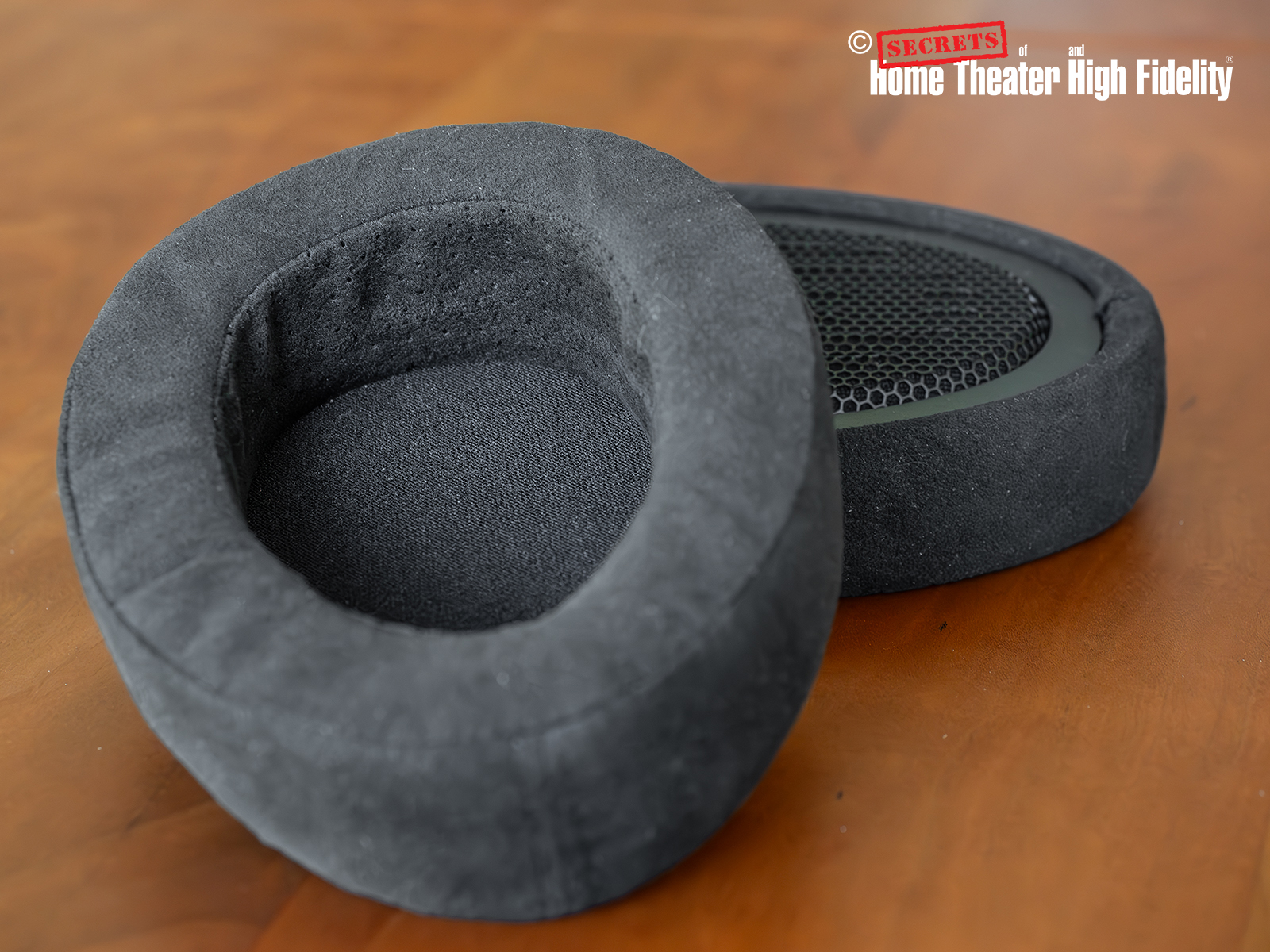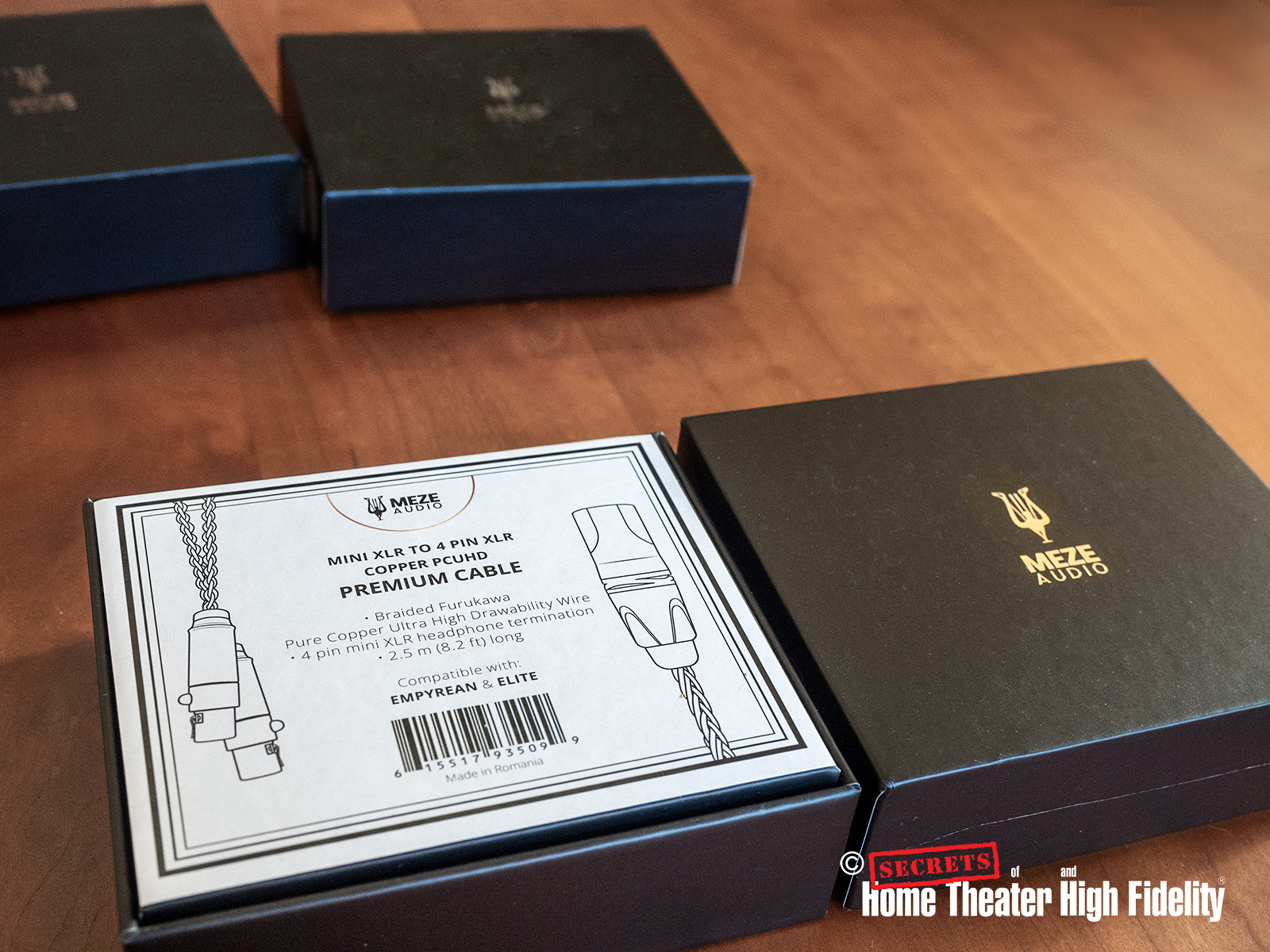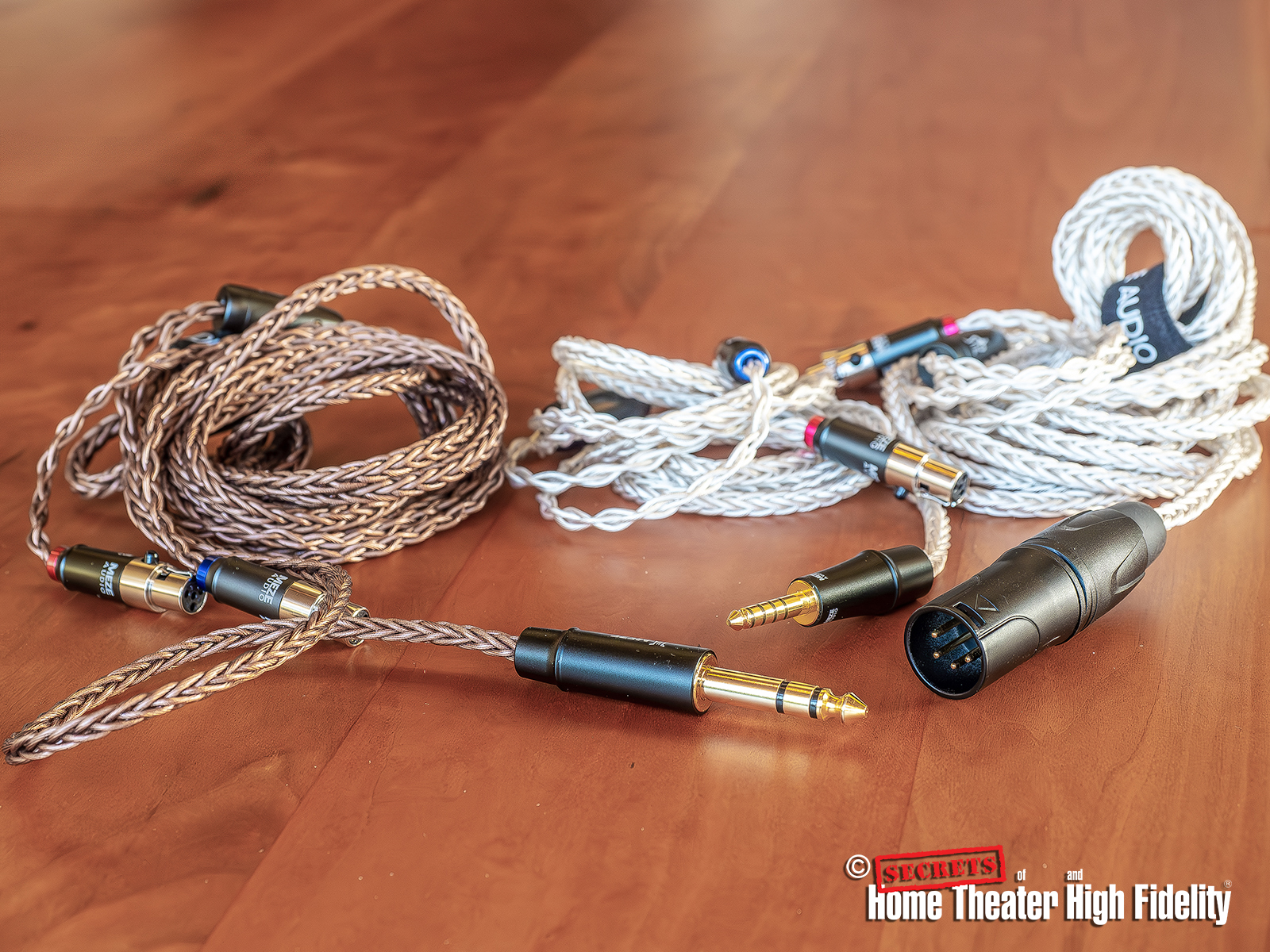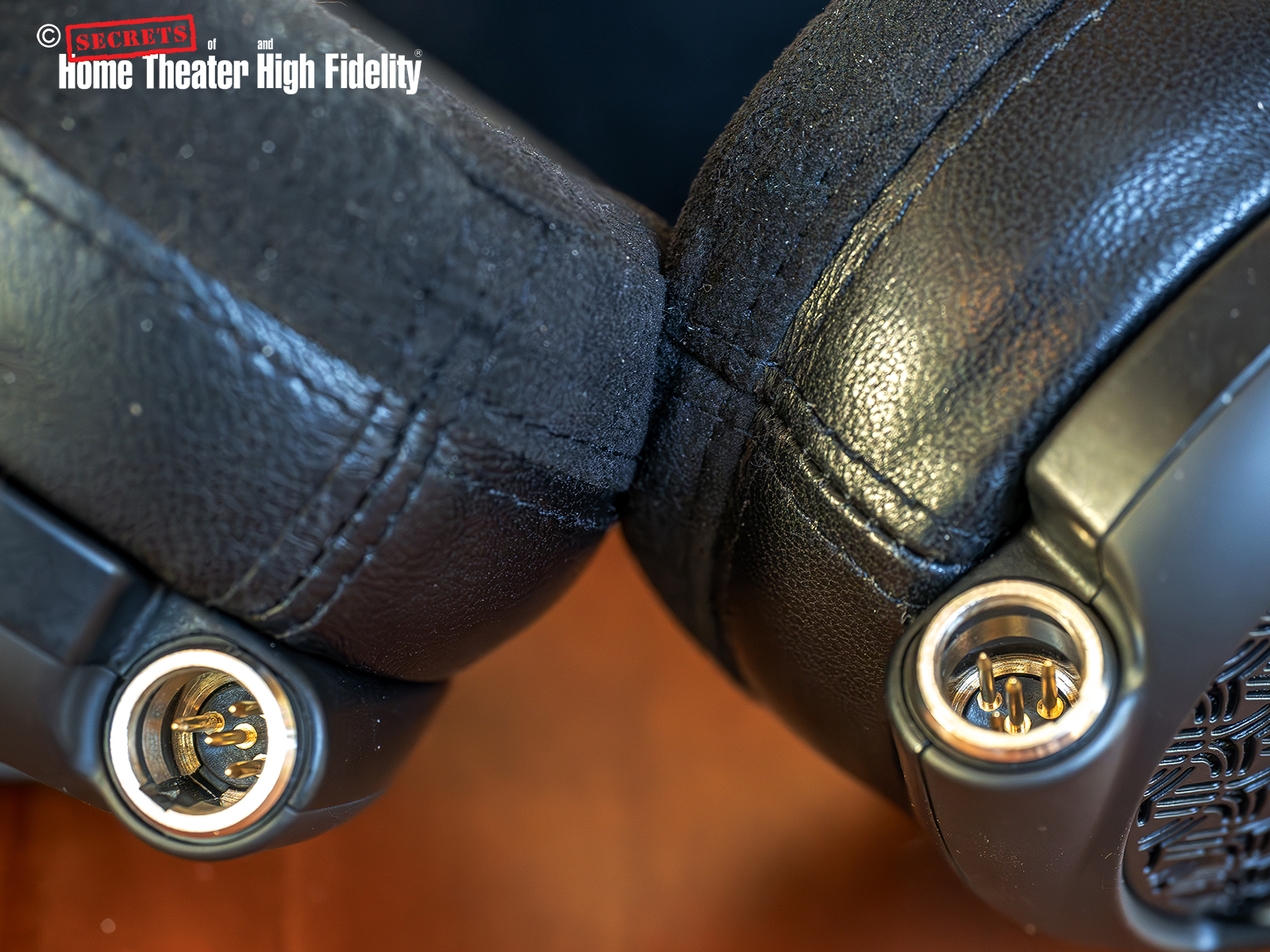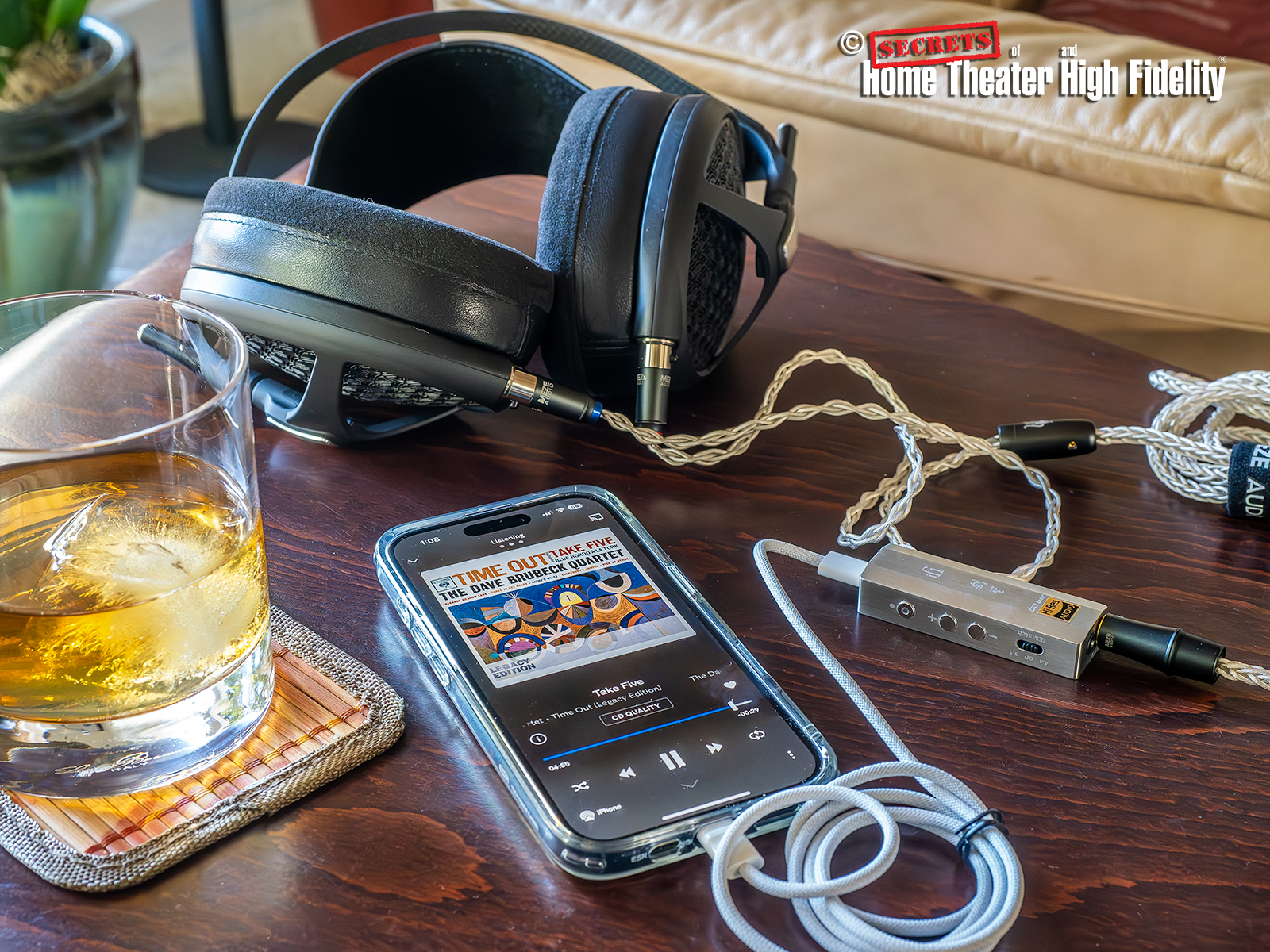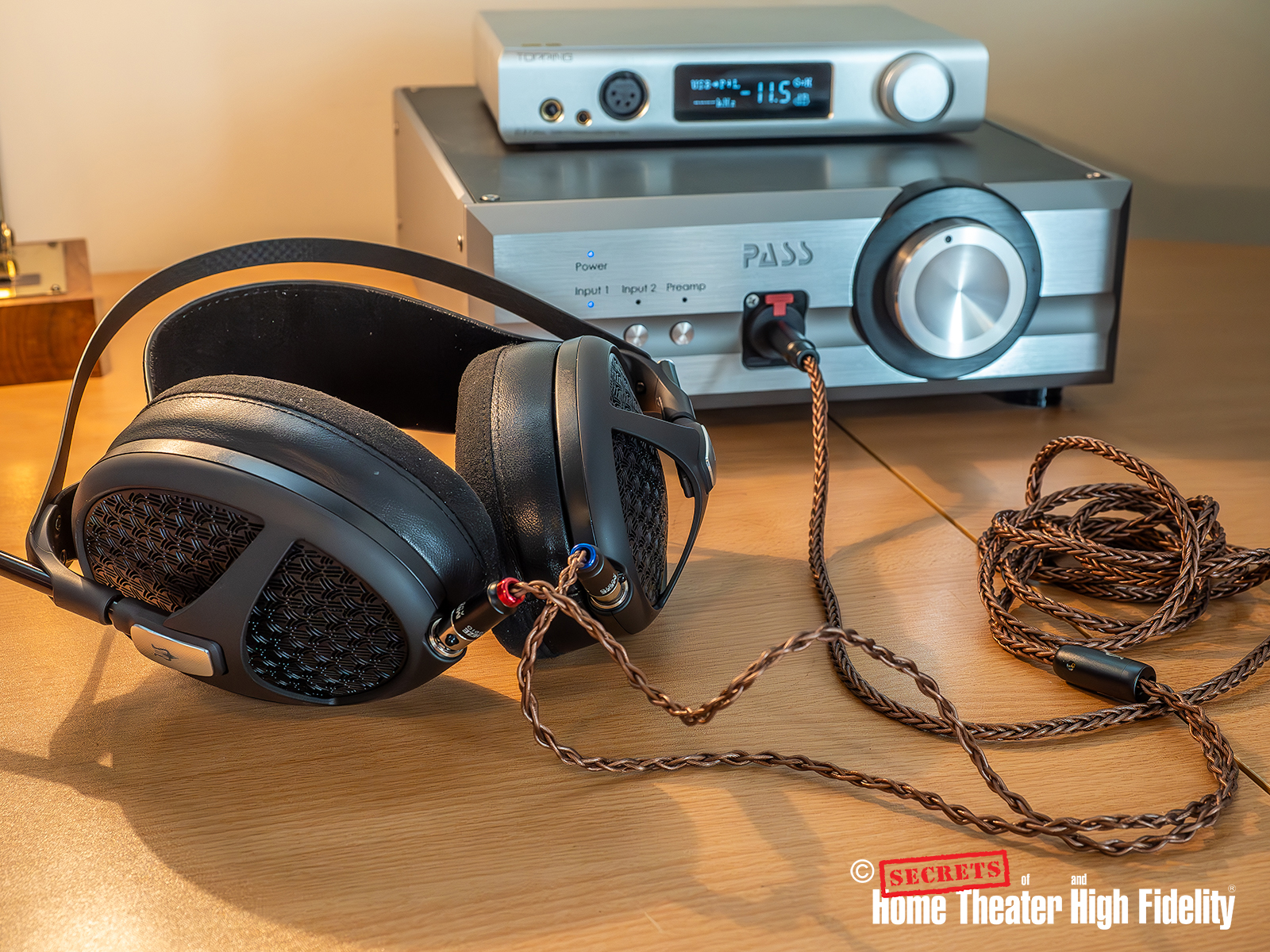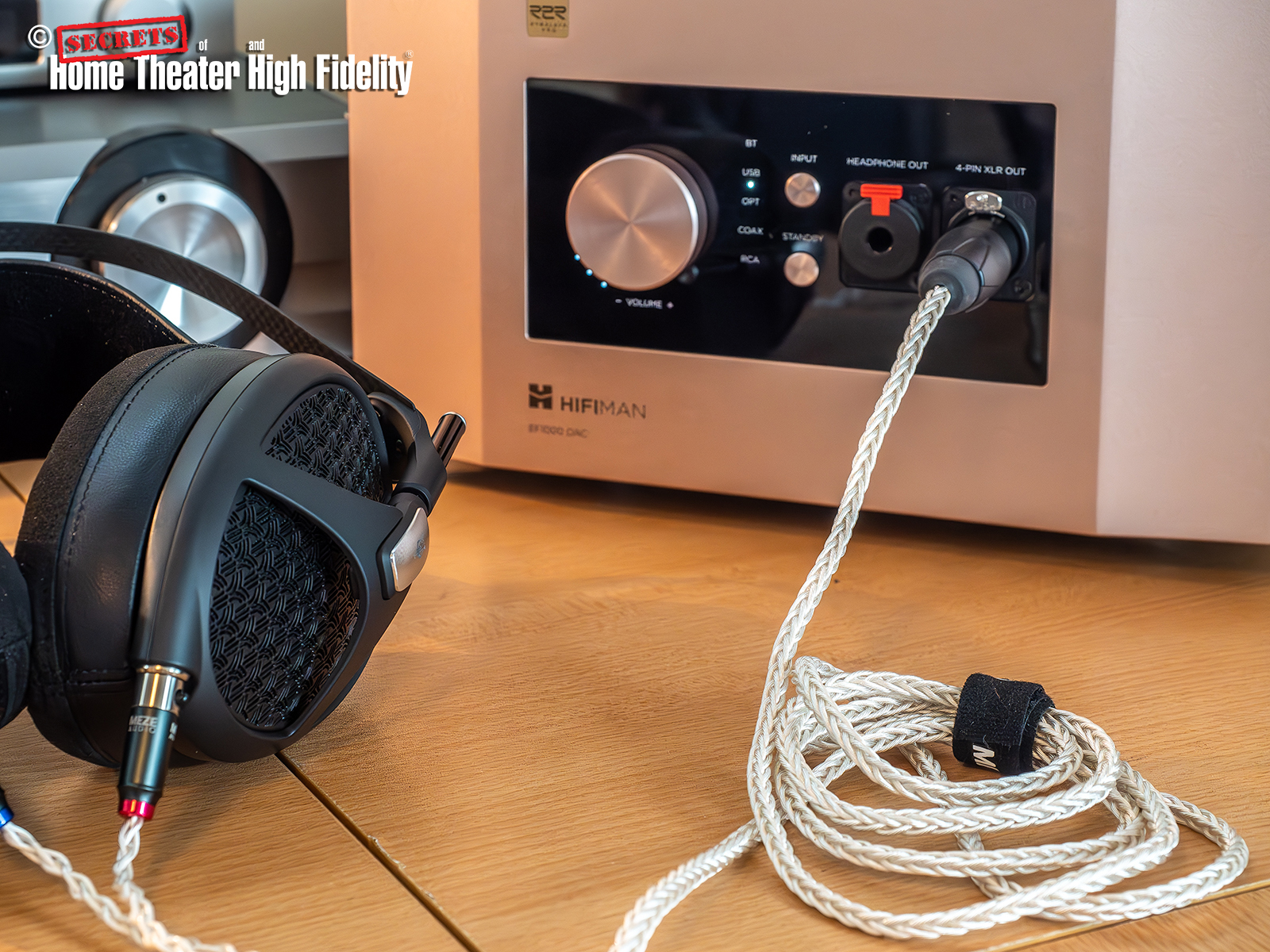The first time I saw them I was mesmerized by how beautiful they were. Listening to several models I found they weren’t just a pretty face. Meze makes serious headphones.
One of the most universally praised headphones on the head-fi scene today is the Meze Empyrean ll, one of Meze’s flagship open-back planar magnetic offerings. Meze generously loaned me a pair for an extended period, which has been a treat, since the only flavor of planar magnetic technology I’m familiar with is from HIFIMAN, and the Empyrean uses the Rinaro MZ3 Isodynamic Hybrid Array planar driver that is unique to the Meze line.
The entire Meze line of headphones embodies a timeless design that is built to last. Tank-like is an overused phrase, but that is what these are. Beautiful industrial design is evident in the smallest detail. The black grill work is a nod to the art deco influence seen throughout the various Meze designs. The carbon fiber headband is silky smooth and understated. The included cables are top-of-the-line, and there are two sets of earpads included that provide two very different sound signatures.
Meze Audio Empyrean II Planar Magnetic Headphones
- Solid and built to last.
- One of the most beautiful headphones I’ve seen.
- Extremely comfortable and ergonomic and provides hours of effortless listening, though the sizing didn’t go quite small enough for me.
- The Duo and Angled Alcantara earpads provide a choice in sound tuning and both are sumptuously comfortable.
- Comes packed in a high-strength ABS plastic suitcase with foam inserts and a handsome leather strap.
- Every part of the chassis can be taken apart and easily replaced if ever needed.
- Accurate sound reproduction through both the spiral and switchback-shaped voice coils in the same driver.
- Powerful bass and extended highs.
- A warm and relaxed sound.
- Premium silver or copper braided Furukawa wire cables are standard.
- Mini XLR connectors on the headphones make a solid cable connection, though tricky to unplug.
“Graba Strica Treaba” is a Romanian saying that good things take time. This is the underlying philosophy of how Meze’s headphones are designed and built. The company was started by Antonio Meze, an industrial designer, in 2011. Started with a small group of friends in Baia Mare, Romania, he had the goal of designing a headphone that would embody stylistic expression, ergonomics, and premium materials.
I had the opportunity to interview Antonio Meze at CanJam SoCal 2024, and I asked him about his background in art and how that influences the designs. Antonio said “From middle school on, I attended art schools. I studied architecture and sculpture, and I think going through all these styles and art history, all the different cultural currents, created this background where all these shapes that we do now come from. If you look at our headphones, you can sometimes find references to Gothic art, Art Deco, Art Nouveau, and so forth. My approach to industrial design is very much from the point of view of the artist, which is more like making something that will create emotion and will resonate with someone else, making something that has meaning or symbol in it. Industrial design often tends to be about trends, trends of shapes, trends of forms, and about pure functionality. But for me, I cannot do it without bringing in this element of artistry.”
I also asked about how they develop new designs. Do they do studies to find out current trends to shape how they bring new headphones to market? He said they don’t do any studies or look at market trends because he and his team design for what delights them and what feels timeless. It is more intuitive. Here is how Antonio describes the process. “So, this is why our industrial design looks a little bit different than other products. I feel like, in general, the landscape of products needs this extra human touch. And that’s why we have this style. So, I look at headphones as art pieces because studying art, you’re used to making something that is supposed to be outside time, outside trend. It’s a piece of culture and it’s not related to any kind of passing trend. And when we do a product design, we approach it in the same way. So, if you look at our products, it’s hard to pinpoint that it belongs to any point in time. For example, the 99 Classics, I would say that if it had been launched 40 years ago, you wouldn’t say how come? It would match forty years ago. But if it’s launched today, or if it’s launched 20 years from now, it still would be just as relevant. It’s not attached to a particular trend. But we try to create something that is somehow unexpected, so we try to create the product, the shape that is… I would say…. Unexpected, is the right word…”
I found this discussion enlightening because it explained why, the first time I saw Meze headphones, I was so enchanted and felt I was seeing art objects not just headphones. The hand-carved walnut wood of the 109 Pro and 99 Classics are an example of this timeless aesthetic.
The Empyrean ll come with two very different earpads and arrive with the leather and Alcantara fabric Duo earpads attached. One of the features that I found useful is the Isomagnetic coupling technology that makes switching earpads effortless. They pull off with a gentle tug and are replaced with a simple alignment and they snap back into place. This is genius as far as I’m concerned, and I wish this was standard on all headphones. This feature made trying out the Angled Alcantara pads easy. I listened to both sets extensively and the difference was major. The Duo pads enhanced bass and warmth and shaved the edges off the sometimes harsh highs. On the other hand, when I felt the music was being colored a bit too dark and heavy, the Angled Alcantara lifted the sound into a brighter and airer tonal space that was almost creating a second set of headphones. I think this is a remarkable accomplishment, and a gift from Meze to offer two different profiles. Prior to this, I hadn’t had any experience in earpad replacement, and I was agnostic on whether there were any benefits in earpad swapping. I’m a believer now.
Driver Type:
Rinaro Isodynamic Hybrid Array Driver
Operating Principle:
Open
Ear Coupling:
Circumaural
Input connector:
dual 4-pin mini-XLR
Frequency Response:
8 Hz to 110,000 kHz
Impedance:
32Ω
Sensitivity:
105 dB SPL/mW @ 1 kHz
Maximum SPL:
>130 dB
Total Harmonic Distortion (THD):
<%.5 (in the whole frequency range)
Weight:
385g (13.6 oz.)
MZ3 Driver specifications:
Rinaro Isoplanar, 8 Hz-110,000 Hz, diaphragm weight 0.16g, driver weight 82g
Website:
Company:
Price:
$2999.00
SECRETS Tags:
Meze Audio, Empyrean II, Planar, Magnetic, Headphones
Secrets Sponsor
The headphones arrived nestled in a hard-sided ABS plastic carrying case. The metal latches are substantial, as is the sturdy black leather handle. Inside the case, egg crate foam cradles the headphones, the second set of earpads, and a box that contains the cables.
The first impression I had when I first took these out of the case was something dark and medieval. Everything is black, from the carbon fiber headband support, and the wing-shaped leather headband strap, to the beautiful etched earcups. The earcups seem massive, though the mass mostly disappears when they are being worn. The earcups are oval and are adjusted by sliding the cups up and down the metal arm. The tension on the slider is just right. The motion is silky smooth yet doesn’t budge once in place. I did wish for a bit more length on the arm as I ran out of room to shorten the earcups up enough for my ears, but I don’t imagine it will be an issue for most listeners.
The heart of the Empyrean ll is the Rinaro MZ3 Isodynamic Hybrid Array Driver. Rinaro is a Ukrainian acoustic engineering company that pioneered the first dual voice coil array to be used in a planar magnetic headphone. They have formed a collaborative partnership with Meze to produce the driver. The diaphragm is manufactured from a thermally stabilized isotropic polymer with a conductive layer. Embedded in the diaphragm are two different voice coil traces. The upper part of the driver is a switchback coil which produces the lower frequencies. A spiral coil which is more efficient at reproducing middle to high frequencies is positioned directly over the ear canal, which, according to Meze, allows sound waves to enter the ear without any time delays. There are neodymium magnets placed symmetrically on both sides of the diaphragm.
The leather headband has a patent-pending wing suspension system that cradles the head. It’s not the most graceful-looking setup, but the support it provides is exceptionally comfortable, especially given the hefty bulk of the earcups. The headband support is provided by a satiny carbon fiber band. There aren’t any sharp edges, and the support provides an effortless balance.
The Duo and the Angled Alcantara earpads are made from soft foam. The outside of the Duo pad is made from premium leather and Alcantara fabric. The inside of the Duo is perforated leather. Meze describes the sound profile provided by the Duo as having a harmonious tonal balance that is good for all musical genres. The Angled Alcantara earpads are fabric both inside and out. Meze describes these as being designed for rendering intricate details and nuances and creating an airy and accurate profile.
As I mentioned, the Empyrean ll came in a sturdy travel case and was packed in egg crate foam. Along with the headphones were the extra earpads, and the most beautiful stock cables I’ve ever seen. These are the premium cables available for purchase. Meze offers a choice of either the silver-plated PCUHD or the Copper PCUHD premium cable in a choice of termination. Mini XLR to 4 pin XLR-2.5m (8.2ft.), 6.3mm-2.5m, 4.4mm-1.3m (4.2 ft.), 3.5mm-1.3m. For my use, Meze sent me every cable to try out, which was terrific, as I wanted to listen to the headphones on every type of amplifier, or dongle DAC/amp I had to play them on. I ended up using them all. I found that the copper cable seemed to smooth the highs and enhance the warmth overall, and the silver lifted the brights and brought an airy quality somewhat like the Angled Alcantara pads, though much more subtle.
The only downside to swapping so many cables was the mini XLR connector on the headphone. I’m familiar with 3.5mm connections but this type of connector was new to me, and I often struggled with the release mechanism. Given the attention to detail in every aspect of the design, I’m sure Meze feels these are the best connectors for their headphone, and perhaps this is something that gets better with practice, but at this point, I’ll take 3.5mm connectors anytime.
The Empyrean ll are fairly easy to drive, and I listened to them on several pieces of gear. I am currently reviewing the iFi Go Bar Kensei portable amp (stay tuned for a future review) and I was able to take the headphones away from my desk and listen to music with my iPhone in the living room. I used the 4.4mm balanced connection. Though the music lost some of the depth and dynamics heard with a desktop amp, there was plenty of volume and kick. I was quite happy with such a portable setup. I scaled up to the Pass Labs HPA-1 connected to the Topping DX7 Pro’s DAC, using the 6.3mm connection. The Pass Labs added energy and dynamics and provided a subtle warmth to the sound. I followed up with using just the Topping DX7 Pro for both amplifier and DAC and, using the 4-pin XLR balanced cable I was delighted by the lively punch it provided, and I think it would be all anyone would need if they wanted to keep a compact and affordable set-up on their desk. Finally, pulling out all the stops, I stepped up to the HIFIMAN EF1000 DAC, again using the 4-pin XLR balanced cable.
What I found is that with every step up in power, the Empyrean ll scaled up with more dynamics and a broader soundstage, and just a bigger sound overall. Oddly, however, with the EF1000 DAC, the upper mids and highs at times took on a sharp edge that would make me wince a bit. In fact, all together, the sound profile of the Empyrean ll took a little getting used to. In fairness to them, I had just come off spending time with the HIFMAN Susvara Unveiled, which excels in crystalline clarity (and cost almost three times the price). When I first started listening to the Empyrean ll, in some songs they sounded both dark and somewhat blurred and overly bright at the same time, and the soundstage was closer and more intimate than what I had become used to. I realized I needed to do an auditory palette cleansing, so I stopped listening to all headphones for a time and then started again with the Empyrean ll. This made a huge difference, and I was able to evaluate them with fresh ears. Though the sound profile still seems both darkish and at times a bit too harsh for my taste, I realized it is just a different sound that Meze is offering, and what at first seemed dark became fullness in the bass region and some sub-bass extension and a warm and relaxed presentation. These headphones, in addition to being refined and beautiful, are also fun and lively.
If there is any headphone that highlights just how personal and unique each of us is in terms of how we perceive sound, the Empyrean ll have been that headphone. In my limited exposure to a variety of headphones, I can tell if I’m listening to a dynamic driver or a planar or electrostatic. This headphone has not been so easy. I know this is an open-back headphone, but it feels like it is closed-back. If I snap my fingers I can hear them, or if I lay them down with music playing, I can easily hear the music, yet when I put them on, I get a similar feeling of isolation as when I put on a closed-back headphone. It is a puzzle, and I think it must come down to how thick and deep the pads are especially when coupled with grill work that has the look of being dense and gives the sense of mass and solidity. So, I realize I have an expectation of how I think music will sound just by how the headphones feel, and perhaps confirmation bias kicks in and colors my perception.
What this has meant for my evaluating these headphones is that it has taken a while to appreciate what they offer, as they don’t sound like I first thought they would. As I mentioned, when I first started listening to music with the Empyrean ll, they sounded dark and a bit muddy, but then the highs would come in and at times sound edgy. However, the more I listened to them, the more the veil of perception lifted, and the more I enjoyed them. At first, I followed what I usually do, which is to switch between the headphones being reviewed and my other headphones to compare. That didn’t work in this case, as it really is apples and oranges, even among planars. I think I still have a lot to learn about brands and “house sound” and how varied brands can be from each other. I feel these needed to be judged on their own, and I’m glad I chose to make them the only headphones I listened to for most of the time.

Jennifer Warnes, “Famous Blue Raincoat”, Songs of Leonard Cohen, 16-Bit CD Quality 44.1 kHz-Stereo, Qobuz
Canadian singer/songwriter Jennifer Warnes was a close friend and frequent collaborator with Leonard Cohen. She toured with him as a backup singer in the ‘70s and appeared on six of his albums. This album presented the music of Leonard Cohen with an earthy, mature regard for the poetry of Leonard’s music. Unlike the more folky interpretation of other female vocalists of the time, Jennifer brings a lived experience that reflects Leonard Cohen’s own. Jennifer’s powerful voice soars on this album, and the song “Famous Blue Raincoat”, which is one of the quintessential Cohen songs, is lush and jazzy, and Jennifer’s interpretation makes it her own.
The song opens with saxophone, bass, and piano and then Jennifer’s clear, warm voice. The delicacy and space were a good test for challenging my initial impression of the Empyreans being dark. In fact, the headphones proved to me that, yes, they really are planars. They did a superb job of presenting the piece in all its airy lightness while giving the plucked strings of the bass a deep resonance. There was extended space around the music that I associate with the “planar magnetic” sound. Her voice was intimate and clear and well separated from the instruments.

Leonard Cohen, “You Want It Darker”, 16-Bit CD Quality 44.1 kHz-Stereo, Qobuz.
Since I opened with the feminine interpretation of Leonard Cohen, I thought I would bookend it with Leonard Cohen and one of his final songs he wrote and recorded one and half months before he died in 2016. As light and airy as Jennifer Warnes is, Leonard is darkly subterranean. Produced by Leonard’s son Adam, Leonard’s declining health at 82 was making it clear that Leonard’s time of writing and recording was rapidly coming to an end. Ever the poet and storyteller/philosopher, Leonard summoned his ghosts and Jewish faith for a final farewell. In “You want it darker”, Leonard sings to his lord, who he refers to as the “dealer” the phrase “Hineni, hineni”, a line found in the Torah which translates to “I am ready”. Backed by the voices of soloist Cantor Gideon Y. Zelermyer and Congregation Shaar Hashomayim Synagogue of Quebec, the largest synagogue in Canada, Leonard seems to return, at the end of his life to his family’s rabbinical roots.
Though it cuts to the bone in its rawness and truth, “You Want It Darker” also rocks with electric bass and Hammond organ played by his longtime friend and musician, Neil Larsen.
This piece gives the Empyrean ll a chance to address my concerns about it being dark sounding, by giving it a dark song. It gave Leonard’s voice the intimacy and closeness that puts him right in front of you while giving the choir a wide stage around him with almost infinite space. A stunning performance brilliantly presented by the technical excellence of the Empyrean ll. They seem made for each other.

Rodney Crowell, Norah Jones, Puss N Boots, “No Fools, No Fun”, Hi-Res 24-Bit, 44.1 kHz-Stereo, Qobuz
I thought it would be nice to move from the big questions to a bit of s**t-kicking fun with Rodney Crowell, and his song “Bull Rider,” performed here with Norah Jones, Sasha Dobson, and Catherine Popper, all of whom perform vocals, guitars, fiddle, and drums when they were performing as Puss N Boots. This album was recorded live in front of an enthusiastic audience in Brooklyn N.Y. pretty much just for the heck of it. Norah Jones though known for her jazz vocals, grew up in Grapevine, Texas, and thought it would be fun to return to her country roots. She and Sasha Dobson and Catherine Popper, all great singers, had wanted to perform together, so they formed a country girl band and cut loose and had some serious fun. Rodney Crowell’s song Bull Rider captures the swing, drama, and dance-with-danger of the rodeo bull rider with some of the best lyrics around. The line, “It’s drink’n beer and pulling trailers, tight lame ́ and barrel racers” reminds me of my own barrel racing youth and makes me plum nostalgic for rodeos. He and the ladies really kick it up. Who knew Norah Jones could fiddle country with the best of them? Can the Romanian Meze Empyreans get down and cowboy? Heck yeah!

Ayub Ogada, “En Mana Kuoyo (Real World Gold)”, 16-Bit CD Quality 44.1 kHz-Stereo, Qobuz
The 2005 film “The Constant Gardener” introduced us to the music of Kenyan singer Ayub Ogada, whose song “Kothbiro” (rain is coming) was the haunting song during the ending credits. Ayub Ogada plays a traditional Luo instrument called the Nyatiti, a lyre-like stringed instrument while singing this traditional African song. A simple lullaby-like song, Kothbiro is hypnotic as his lush, gentle voice and traditional instruments play softly, layer upon layer. Sometimes it is the quietest and most spare music that reveals what a headphone can deliver, and every nuance and shimmer of the instruments is created warmly and precisely. The Empyrean ll presents voices and instruments with texture and presence, revealing the tiniest details and placement in a fairly wide soundstage that seems to scale the space realistically.
Secrets Sponsor
The Meze logo is a stylized image of the beautiful male Lyrebird. They are known for their extraordinary ability to mimic natural and artificial sounds in their environment.
- Warm, rich sound that still provides detail and accuracy.
- A complete package of choices for earpads and cables. The braided cables are light and flexible.
- Industrial design that reflects a respect for the history of artistic movements, i.e. Art Deco, Gothic, etc.
- Build quality that conveys attention to the smallest detail and is clearly built to last.
- Replaceable parts! Yes, the build quality is there, but life happens, and Meze is ready to help.
- Comfort. Not the lightest headphones, but the suspension system is brilliant and allows for hours of listening.
- A wireless version?
- At least one more stop on the sizing for smaller heads.
Not only do I think Lyrebird makes for a lovely logo but is a brilliant way to express what the Meze Empyrean ll have revealed to me, which is their ability to adapt to any genre of music with accuracy and lush warmth.
I previously associated warmth with loss of detail, but I’ve grown fond of the Meze “sound” that I’ve heard in their various models. I’m a visual thinker, and the image that comes to mind is of the glow of a fire in a cabin, or the beauty of the woods that Meze has used in some of their headphones.
Easy to drive, yet highly scalable depending on the amplifier, this can be a headphone that can be both audiophile “serious” yet fun and lively. It has been an education for me to expand my thinking on what a planar magnetic headphone can sound like (great bass), and the fact that earpads and cables can make a difference in shaping sound.


